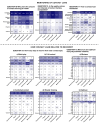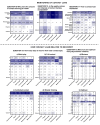Contact load practices and perceptions in elite English rugby league: an evaluation to inform contact load guidelines
- PMID: 39234298
- PMCID: PMC11374316
- DOI: 10.17159/2078-516X/2024/v36i1a17646
Contact load practices and perceptions in elite English rugby league: an evaluation to inform contact load guidelines
Abstract
Background: Athlete exposure to contact could be a risk factor for injury. Governing bodies should provide guidelines preventing overexposure to contact.
Objectives: Describe the current contact load practices and perceptions of contact load requirements within men's and women's rugby league to allow the Rugby Football League (RFL) to develop contact load guidelines.
Methods: Participants (n=450 players, n=46 coaching staff, n=32 performance staff, n=23 medical staff) completed an online survey of 27 items, assessing the current contact load practices and perceptions within four categories: "current contact load practices" (n=12 items), "perceptions of required contact load" (n = 6 items), "monitoring of contact load" (n=3 items), and "the relationship between contact load and recovery" (n=6 items).
Results: During men's Super League pre-season, full contact and controlled contact training was typically undertaken for 15-30 minutes per week, and wrestling training for 15-45 minutes per week. During the in-season, these three training types were all typically undertaken for 15-30 mins per week. In women's Super League, all training modalities were undertaken for up to 30 minutes per week in the pre- and in-season periods. Both men's and women's Super League players and staff perceived 15-30 minutes of full contact training per week was enough to prepare players for the physical demands of rugby league, but a higher duration may be required to prepare for the technical contact demands.
Conclusion: Men's and women's Super League clubs currently undertake more contact training during pre-season than in-season, which was planned by coaches and is deemed adequate to prepare players for the demands of rugby league. This study provides data to develop contact load guidelines to improve player welfare whilst not impacting performance.
Keywords: contact training; load; rugby league.
Conflict of interest statement
Conflict of interest and source of funding: The authors declare no conflict of interest and no source of funding.
Figures






Similar articles
-
I won't let you down; why 20% of Men's and Women's Super League players underreported suspected concussions.J Sci Med Sport. 2023 Dec;26(12):688-693. doi: 10.1016/j.jsams.2023.09.015. Epub 2023 Sep 27. J Sci Med Sport. 2023. PMID: 37813720
-
The field and resistance training loads of academy rugby league players during a pre-season: Comparisons across playing positions.PLoS One. 2022 Aug 9;17(8):e0272817. doi: 10.1371/journal.pone.0272817. eCollection 2022. PLoS One. 2022. PMID: 35944037 Free PMC article.
-
The Perceptions of Elite Professional Rugby League Players and Staff on the National Rugby League Annual Calendar: A Mixed-Methods Study.Sports Med Open. 2023 Jun 13;9(1):45. doi: 10.1186/s40798-023-00586-4. Sports Med Open. 2023. PMID: 37310521 Free PMC article.
-
Applied physiology of rugby league.Sports Med. 2008;38(2):119-38. doi: 10.2165/00007256-200838020-00003. Sports Med. 2008. PMID: 18201115 Review.
-
Incidence of injury in junior and senior rugby league players.Sports Med. 2004;34(12):849-59. doi: 10.2165/00007256-200434120-00004. Sports Med. 2004. PMID: 15462615 Review.
References
-
- Daneshvar DH, Nair ES, Baucom ZH, Rasch A, Abdolmohammadi B, Uretsky M, et al. Leveraging football accelerometer data to quantify associations between repetitive head impacts and chronic traumatic encephalopathy in males. Nat Commun. 2023 Jun 20;14(1):3470. doi: 10.1038/s41467-023-39183-0. - DOI - PMC - PubMed
LinkOut - more resources
Full Text Sources
